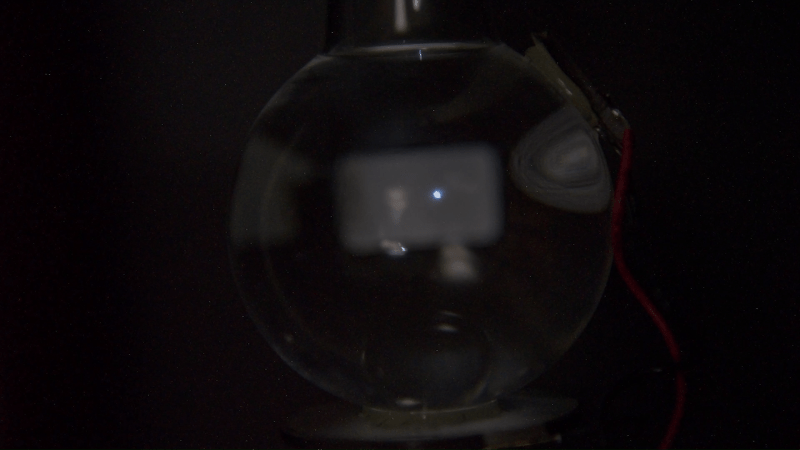If nothing else, [Justin Atkin] is persistent. How else do you explain a five-year quest to create sonoluminescence with simple tools?
So what exactly is sonoluminescence? The short answer is as the name suggests: a release of light caused by sound. In [Justin]’s case, he used an ultrasonic transducer to set up a standing wave at the resonant frequency of a flask of water. A drop of water is used to entrain a small air bubble, which is held in a stable position in the flask in much the same way as styrofoam beads are in an acoustic levitator. Turn off the lights and you’ll see that the bubble glows with a ghostly blue light.
What causes the glow? Good question. According to [Justin], we just don’t know for sure what causes it, although the leading theory is that cavitation of the bubble causes the trapped gas to compress and heat violently, turning into a brief bit of plasma. But there are problems with that theory, which is one of the reasons he wanted to show just how easy the process can be – now that he’s shaken out the bugs with five years of effort. It wasn’t easy getting the transducers attached and the driver circuit properly tuned, but with little more than a signal generator, an audio amp, and a spool of magnet wire, you too can make your own “star in a jar.”
We applaud [Justin]’s determination to bring this project to a successful conclusion. It’s not unlike his dogged effort to make a cold plasma torch, or even his desktop radio telescope.
Thanks to [Käpt’n Blaubär] for the tip.















A blue glow in water sounds suspiciously like Cherenkov Radiation https://en.wikipedia.org/wiki/Cherenkov_radiation I wonder if the air in the bubble is emitting photons somehow, which are then exceeding the speed of light in water, and shed the remaining energy as the blue glow?
Cherenkov radiation is produced when charged particle exceed the speed of light. Photons are not charged. (I have no basis to suspect it is so, but it may be possible that) If the water molecules are being ionized, it may be possible that electrons are producing Cherenkov radiation.
Very good point – it’d need to be a charged particle. I hadn’t considered that.
You also neglected the fact that photons are light, so they cannot exceed the speed of light by definition. The speed of the photon in a medium defines the speed of light in that medium.
Cherenkov light looks blue because it has a rising spectrum, so your eye perceives it as blue, which is the highest frequency your eye responds well too. Lots of processes have that same property, like Rayleigh scattering.
It is more likely bremsstrahlung radiation due to free electrons in the ionized gas within the bubble being released and producing light.
See: https://en.wikipedia.org/wiki/Mechanism_of_sonoluminescence#Light_emission
Also at the referenced temperatures the bubble is likely experience a state change to plasma (which produces light with free electrons). ref: https://physics.aps.org/articles/v7/72
Likely both. And more!
Yes it emits photons.
does this work with ultrasonic vaporizers and similar devices that are used as fog machines in a bowl like you see in novelty shops and zen shops?
of course the leds would need to be disconnected
while the person was stripped of his awards for fraud i think the patent offices should strip the patents and maybe even nullify them and should have a rule that all patents have to have a working prototype to get a patent.
also instead of being a leonardo davinci if anyone has any whing against the experiments should not get involved with them rather than omitting or changing the notes in a way to prevent recreating.
also if there is any dangers like dealing with acids or the possibility of fire or smoke the proper warnings should be listed like the video mention when mentioning that sulfuric acid is being used.
The patent doesn’t necessarily have anything to do with any extraordinary claims. Like “Device for generating luminous bubbles in liquids”, doesn’t contain any claims of cold fusion etc. it just makes bubbles that shine light.
Lighten up, Francis.
Yes, Sgt Big Toe.
I wonder if you used carbonated water, would it make the flask get really hot, ‘at an alarming rate…’?
H2SO4 probably works better due to S0+ being generated. Google “sulfur light”
Random thought, what if the energy for the light comes from outside the flask. Your bubble acts like an antenna, picks up radiation from outside, then eventually dumps it.
Easy to test, shield the flask and repeat your test.
Don’t let Morgan Freeman find out you have this technology…
Does the colour change if your use a micro controller with a different coloured power LED?